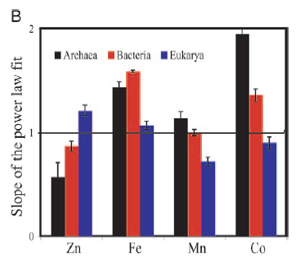UC San Diego Scientists Establish Connection Between Life Today and Ancient Changes in Ocean Chemistry
San Diego, CA, November 6, 2006 -- Researchers in computational biology and marine science have combined their diverse expertise and found that trace-metal usage by present-day organisms probably derives from major changes in ocean chemistry occurring over geological time scales.
|
Using protein structures for the first time in such a study, the research establishes one of the influences that geochemistry has had upon life.
The study, published in this week's edition of the Proceedings of the National Academy of Sciences, sought to verify the theory that the rise in atmospheric oxygen some 2.3 billion years ago, and attendant shifts in ocean chemistry, led to changes in types of metals used with protein structures. Such changes are hypothesized to have led to the diversification and increased complexity of the life we see today.
Scientists Chris Dupont, Song Yang, Brian Palenik and Philip Bourne from the San Diego Supercomputer Center (SDSC), Scripps Institution of Oceanography, and the departments of chemistry and biochemistry and pharmacology at the University of California, San Diego (UCSD) analyzed the metal-binding characteristics of all known protein structures found in all kingdoms of life. [The findings were also featured recently at the Calit2-organized Metagenomics 2006 conference; to read the authors' poster abstract, click here .]
"Protein structures are ideal for this study," Bourne said, "since they are much more conserved than protein sequences, traditionally used in such studies and, furthermore, metal binding can be inferred directly."
Using data generated by Dupont and Yang, the group established that the three superkingdoms of life - Archaea, Bacteria and Eukarya -- all use metals differently. The differences reflect the availability of such metals in the ocean as the respective superkingdoms evolved.
The authors conclude that, "these conserved trends are proteomic imprints of changes in trace-metal bioavailability in the ancient ocean that highlight a major evolutionary shift in biological trace-metal usage."
The changes in trace-metal availability are believed to have been brought about by the biologically caused rise in atmospheric oxygen some 2.3 billion years ago, highlighting the co-evolution of biology and geochemistry on a global scale.
"Here, a biological phenomenon, photosynthesis, changed the availability of trace metals in the oceans," Dupont said, "resulting in a reciprocal change in biological evolution still observable today."
The group notes that, "such studies linking the study of the earth sciences with that of the life sciences are limited and certainly no one has previously looked at this exciting area from the perspective of protein structure. We hope this will encourage others to undertake such interdisciplinary work."
Related Links

